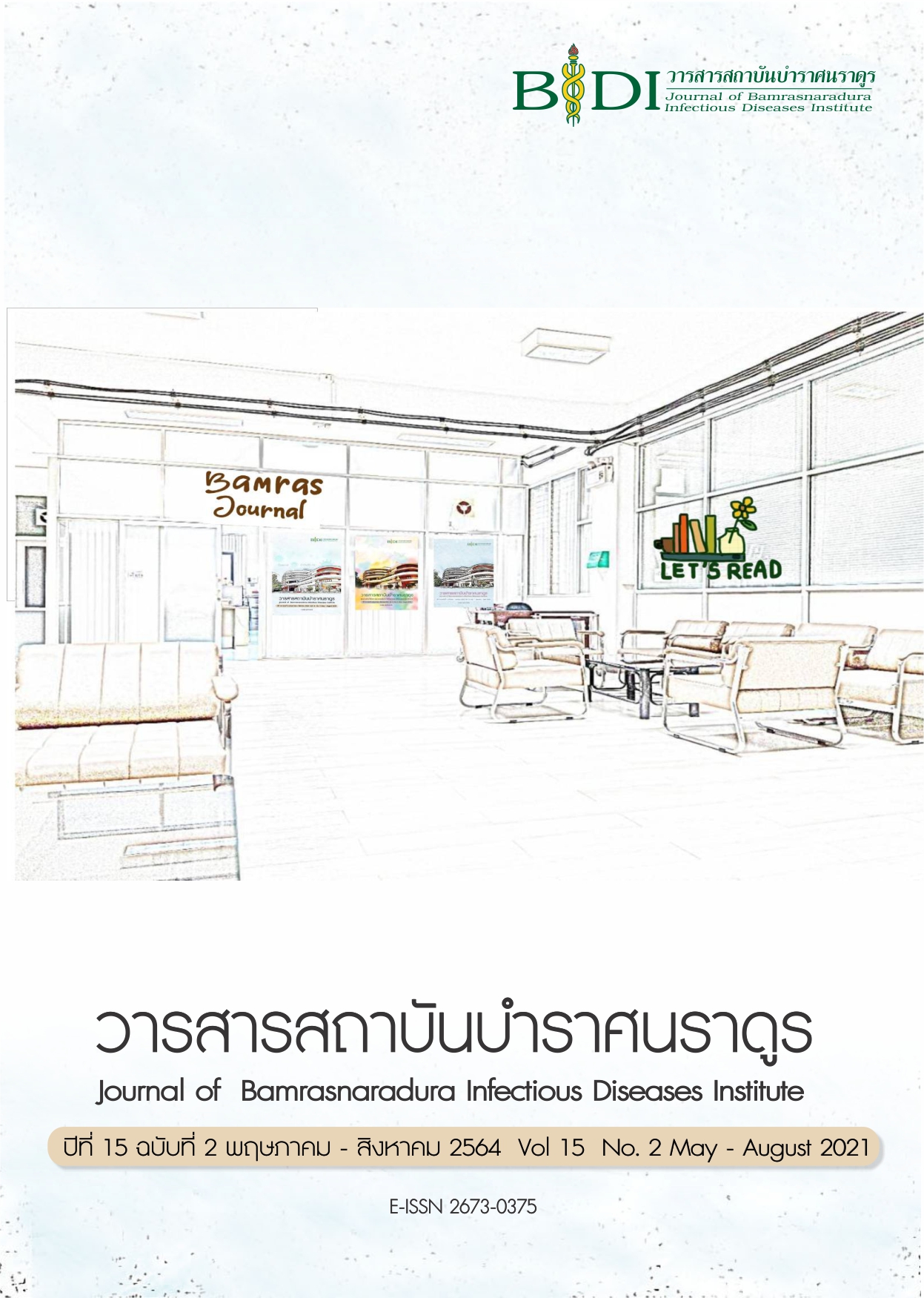The Effects of Smoking Prevention Program and Using Facebook Among Grade 8 Students, Amphoe Mueang, Prachuap Khiri Khan Province
Main Article Content
Abstract
Smoking initiatives in children and adolescents lead to cigarette addiction and the use of more dangerous drugs in the future, so prevention of new smokers is important. This quasi-experimental research aimed to study the effects of smoking prevention programs and using Facebook, applying the Social Cognitive Theory among grade 8 students in Amphoe Muang, Prachuap Khiri Khan Province. The samples were 54 students which were divided into experimental group (31 students) and comparison group (23 students). The experimental group participated in the smoking prevention program applying the Social Cognitive Theory and Facebook for designing activities for 8 weeks, including providing knowledge and building self-efficacy for not smoking. The program composed of lecture with slides, watching VDO and you tube, group discussion, games, creating an environment enabling learning, exhibition and joining the Facebook group for learning exchange. Pre-post intervention data were collected by questionnaires and analyzed by descriptive statistics and compared the difference with Kolmogorov-Smirnov test, Chi – square, Independent t – test, Paired t-test, ANCOVA, McNemar test and Odd ratio at 95% CI.
The results showed that the experimental and the comparison group have had similar characteristics respectively (p>0.05). Within group comparison after the experimentation, the experimental group had significantly higher changes with regards to knowledge about negative effects and dangers of smoking (SD=2.48, p<0.011), perceived self-efficacy to stop smoking (SD=8.41, p=0.036), outcome expectation of non-smoking (SD=6.71, p<0.001) and intention to stop smoking than, before the experimentation significantly (p=0.039). Excepting the attitude to non-smoking of the experimental group, it had not significance (SD=10.06, p=0.073). While within comparison group, it had not significance in all dimensions (p>0.05). For between group comparison after the experiment with ANCOVA, the experimental group had higher mean of knowledge about negative effects and dangers of smoking than comparison group significantly (p<0.001) while it had not significance in the other dimensions (p>0.05)
Thus, the activities and the processes of this smoking prevention program and using Facebook could be developed and applies in teaching secondary school students. Nevertheless, interesting techniques, monitoring and stimulating the use of Facebook regularly should be done and add activity of skill development.
Article Details
References
Rungruanghiranya S, and Kongsagon R. Tobacco: toxicity, therapy and prevention. Nakhonpathom: Sintaweekit printing; 2013. (in Thai) .
Phittayarungsarhit S, and Punkrachang P. Thailand Tobacco Consumption Statistics Report, 2018. Bangkok: Tobacco Control Research and Knowledge Management Center, (TRC.), Mahidol University; 2018. (in Thai)
Bunsem K, Sathitiwanich P, and Rawisanorn W. Smoking Behaviors among Youth in Chaiyaphum Province. Journal of health science 2009; 3: 6-14. (in Thai)
Jarungjitaree S, Ammawat W, and Wichitsranoil J. Factors Influencing Smoking Behavior among Women in Urban Areas. Journal of Public Health 2013; 43(3): 281-95. (in Thai).
Pornvivattanachai S. Factors influencing adolescents smoking behavior. Nakhonprathom . Mahidol University; 2010. (in Thai)
Kengganpanich T., Kengganpanich M. and Temsirikunchai L,, Factors Influencing on Young Women Smoking in Thailand. Journal of Health Education 2008; 30(1) : 26-40. (in Thai)
Thippayom T. and Nimpitakpong P., Electronic Cigarettes. Journal of Public Health 2014; 3:313-28. (in Thai)
Bureau of tobacco control, Department of Disease control, Ministry of Public Health and Tobacco Control Research and Knowledge Management Center (TRC.). The 2016 Situation of tobacco in Thailand Bangkok. Bangkok: Chalearndemunkong print; 2016. (in Thai)
Laysamute S, Jamthaworn S, Leenawarat T, Tapanya S, and Saelim. A. Exploring the situation and marketing mix of new tobacco products consumption among teenage consumers. Bangkok: Tobacco Control Research and Knowledge Management Center (TRC.) and Thaihealth; 2012. (in Thai)
National statistical office. The 2017 Household survey on the use of information and communication technology. Bangkok: Ministry of Digital Economy and Society; 2017. (in Thai)
Aemsuthasit S. Theories and techniques in behavior modification. 8th ed. Bangkok: Chulalongkorn University Press; 2013. (in Thai)
Kaewsutha N, Auncheun P, Somsuay P, Weerakul N. The effect of positive tobacco refusal program in dental school program of primary school students, Bangkok. Journal of Srinakharinwirot Research and Development (Humanities and Social Sciences) 2018; 9(17): 53-68. (in Thai)
Fleiss JL. Statistical Methods for Rates and Proportions. New York: John Wiley & Sons; 1981.
Rogers RW, Prentice-Dunn S. Protection motivation theory. In: Gochman DS, Editor. Handbook of health behavior research 1: Personal and social determinants. New York: Plenum Press; 1997. P.113–32.
Krathwohl DR, Bloom BS. Taxonomy of Education Objective; Handbook II : Affective domain. New York: David Mckay company: 1964.
Aemsuthasit S. Theories and techniques in behavior modification. 8th ed. Bangkok: Chulalongkorn University Press; 2013. (in Thai)
Dale E. (1946), The Cone of Learning. [Internet]. 2018 [cited 2018 June 20]. Avialable from: https://en.wikipedia.org/wiki/Edgar
Chaikoolvatana C, Sutti P, Jaimalai W. Smoking Behavior and Risk Factors Associated with Smoking of Early Adolescents in Phayao Province, Thailand. Nursing Journal of the Ministry of Public Health 2018; 27(3): 57-67. (in Thai)
Issarasongkhram M, Boonprakong T, Chunkao K. Knowledge attitude and behavior in prevention control of communicable diseases between individualized instruction by principles of environmental education and teaching large groups. Journal of the office of Disease Prevention and Control 7th Khon Kaen 2017; 24 : 91-104. (in Thai)
Hamill S, Turk T, Murukutla N, GhamrawyM, Mullin S. I like MPOWER: using Facebook, online ads and new media to mobilise tobacco control communities in low-income and middle-income countries. Tobacco control Journal 2015; 24(3): 306-12.
Punsai K, Rodjarkpa Y, Pongsangpun P. Effect of short movie for smoking prevention behavior among junior high school. Journal of the office of Disease Prevention and Control 7th Khon Kaen 2017; 24(2): 90-9. (in Thai).
Suwamard J. The effects of a smoking prevention program for early male adolescents in foster home. [Dissertation]. Nakornprathom: Mahidol University; 2015. (in Thai)
Doloh Y, Kengganpanich M, Kengganpanich T, Benjakul S. Effects of life skill development program on non-smoking intention in youth of Banklang muslim community, Bangtoei sub-district, Mueang district , Pang-Nga Province. Journal of Health Education 2017; 40(2): 10-21.
(in Thai).

